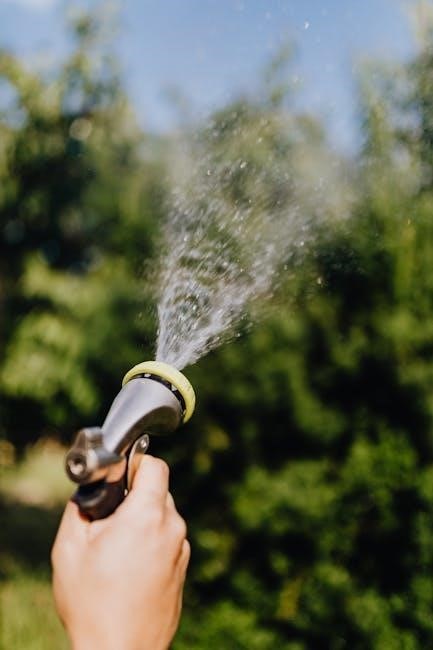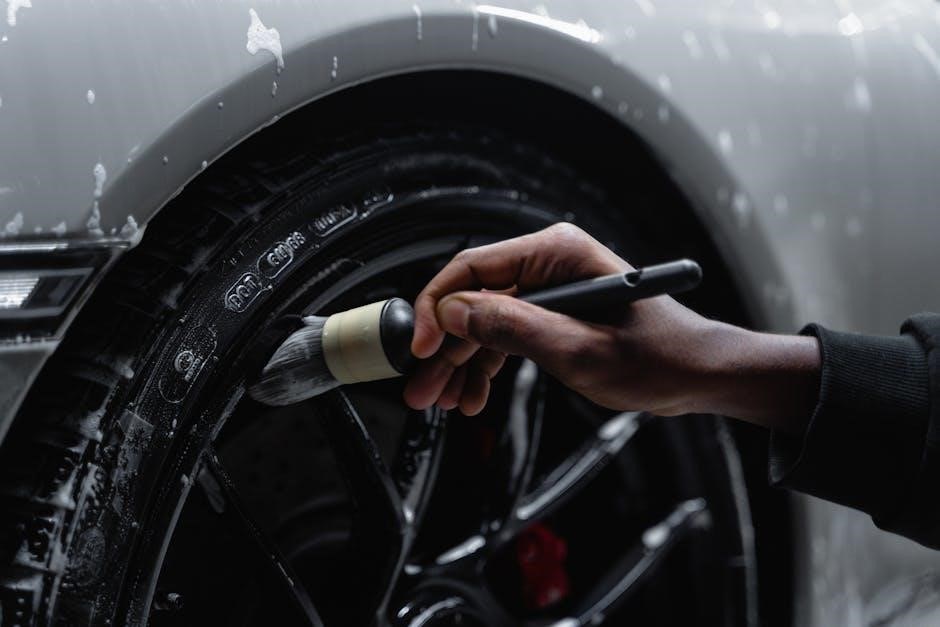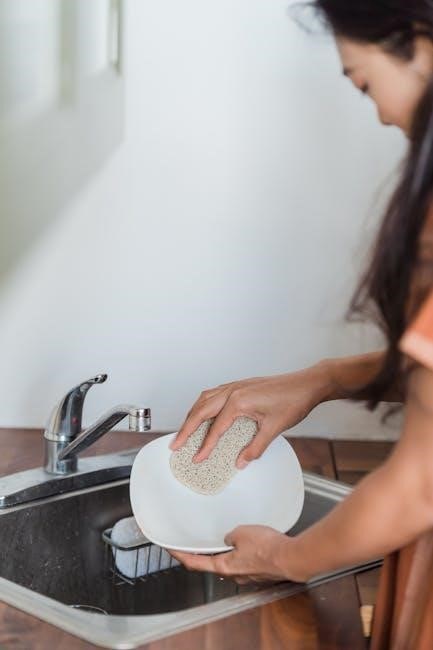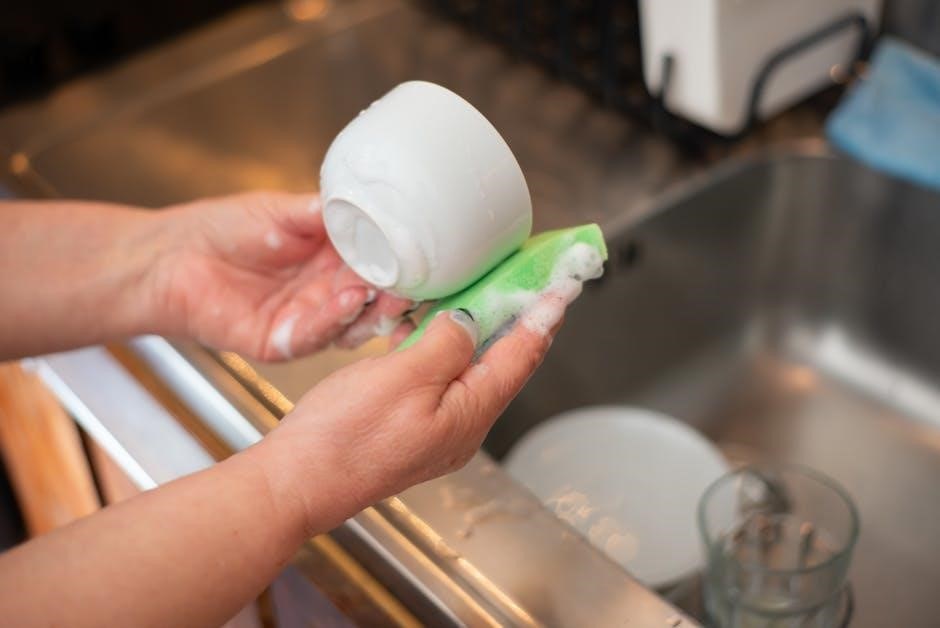Manual water softener regeneration restores efficiency by flushing built-up minerals from the resin bed, ensuring soft water production. While modern systems regenerate automatically, manual intervention is sometimes necessary.
1.1 What is Manual Regeneration?
Manual regeneration is a process where you initiate the water softener’s cleaning cycle to remove accumulated minerals from the resin bed. It involves dissolving salt to create a brine solution, which flushes out hardness minerals like calcium and magnesium, restoring the softener’s efficiency. This process ensures soft water production continues uninterrupted. While modern systems often regenerate automatically, manual regeneration is useful during specific situations, such as low salt levels or increased water demand, to maintain optimal performance and water quality.
1.2 Importance of Regular Regeneration
Regular regeneration is crucial for maintaining your water softener’s performance and ensuring continuous soft water supply; Over time, the resin bed becomes saturated with hardness minerals, reducing efficiency. Without regular regeneration, calcium and magnesium buildup can lead to hard water returning, damaging pipes and appliances. Regular regeneration removes these minerals, restores the resin’s capacity, and prevents system malfunctions. It ensures optimal water quality, protects household fixtures, and extends the lifespan of the water softener, making it a vital maintenance practice.
Manual regeneration is essential when your water softener runs out of salt or malfunctions, ensuring uninterrupted soft water supply and preventing mineral buildup that can affect performance. Noticing hard water returning, decrease in water pressure, or mineral buildup on appliances indicates your water softener needs manual regeneration. Additionally, if the system runs out of salt or experiences malfunctions, such as the metering gears being clogged, manual regeneration becomes necessary to restore functionality. You may also need to regenerate manually during high water demand periods or after extended inactivity to ensure optimal performance and prevent resin degradation. Always look for these signs to maintain soft water quality. Failing to regenerate your water softener can lead to hard water returning, causing mineral buildup in pipes and appliances. This results in reduced water pressure, damaged fixtures, and higher maintenance costs. The resin bed becomes saturated with minerals, diminishing its ability to soften water effectively. Over time, neglecting regeneration can shorten the system’s lifespan and reduce its efficiency, requiring costly repairs or even replacement. Regular regeneration is essential to maintain soft water quality and system performance. Manual regeneration involves dissolving salt, flushing minerals from the resin bed, and rinsing to restore efficiency. This process ensures optimal water softening performance consistently. Preparing for manual regeneration involves ensuring the brine tank is filled with salt and allowing time for the salt to dissolve into a brine solution. This step is crucial as the brine is essential for rejuvenating the resin bed. Additionally, it is advisable to review the user manual for specific instructions, as different systems may have varying requirements. Proper preparation ensures the regeneration process is effective and maintains the water softener’s efficiency. Initiating the regeneration cycle varies depending on the type of water softener. For systems with a digital control valve, press and hold the “Regen” button until the cycle starts. Mechanical systems may require turning a knob or using a screwdriver to advance the regeneration tab. Non-electric models often involve manually activating the cycle via a control valve. Always refer to the user manual for specific instructions. Once started, the system will automatically proceed through the regeneration process, ensuring the resin bed is cleaned and restored for optimal performance. During manual regeneration, monitor the process to ensure it runs smoothly. Check the control valve to confirm the cycle is advancing through its stages. Listen for sounds indicating water flow and brine injection. Periodically inspect the brine tank to ensure it has enough solution. Refer to the user manual for cycle durations. Watch for any signs of blockages or unusual noises. Monitoring ensures the resin bed is properly flushed and the system returns to optimal performance. This step is crucial for maintaining soft water quality. Manual regeneration involves dissolving salt, flushing minerals, and rinsing the system to restore efficiency. Follow these steps to ensure optimal soft water production. Dissolving salt in water creates a brine solution essential for regeneration. Add salt to the brine tank, ensuring it dissolves completely. This solution flows through the resin bed during regeneration, replacing calcium and magnesium ions with sodium ions, restoring the softener’s efficiency. Proper salt levels and complete dissolution are crucial for effective regeneration, ensuring soft water production. Always follow the manufacturer’s guidelines for the correct salt dosage to avoid over- or under-regeneration, which can affect system performance. Flushing minerals from the resin bed is a critical step in manual regeneration. The brine solution flows through the resin, removing accumulated calcium and magnesium ions. This process ensures the resin bed is cleaned and restored to its softening capacity. The minerals are then rinsed out of the system, typically through a drain. Proper flushing is essential to maintain water quality and prevent hard water issues. Regular maintenance ensures the resin bed remains functional and efficient. Rinsing is the final step in manual regeneration, ensuring all brine and minerals are removed from the resin bed. This process restores the softener’s efficiency, allowing it to effectively remove hardness ions again. After rinsing, the system is ready to provide soft water consistently. Proper rinsing prevents any residual brine from affecting water quality, ensuring optimal performance and prolonging the lifespan of the resin and system components. Regular rinsing maintains the softener’s effectiveness and overall water quality. Water softener systems utilize three main types of control valves: digital, mechanical, and non-electric. Each type offers unique features for regulating regeneration cycles and water flow efficiently. Digital control valves offer advanced features for water softener management. They allow users to program regeneration cycles based on water usage patterns, ensuring efficient operation. With a digital display, users can easily monitor system status and initiate manual regeneration by pressing and holding the Regen button. These valves provide precise control over the ion exchange process, optimizing resin performance and water quality. They are ideal for homes with varying water demands, offering flexibility and convenience. Regular updates and diagnostics further enhance their functionality. Mechanical control valves operate without electricity, relying on manual adjustments to initiate regeneration. Users typically rotate a knob or use a screwdriver to advance the cycle. These valves are straightforward, durable, and suitable for homes with basic water softening needs. While they lack the programmable features of digital models, they offer reliable performance and simplicity. Manual operation ensures control over the regeneration process, making them ideal for those preferring traditional systems. Regular maintenance ensures optimal functionality and longevity. Non-electric control valves function without electricity, relying on water flow or manual intervention to trigger regeneration. These valves are ideal for off-grid homes or areas with frequent power outages. Users typically require a screwdriver to activate the regeneration cycle by adjusting internal mechanisms. While less automated than digital or mechanical options, they provide dependable performance and simplicity. Regular maintenance is essential to ensure proper operation and extend the lifespan of the valve; This design offers a cost-effective solution for basic water softening needs. Manual regeneration is necessary after running out of salt, during high water demand, or following extended inactivity to restore soft water production and system efficiency; When your water softener runs out of salt, its ability to remove hardness minerals diminishes. Without salt, the resin cannot regenerate, leading to hard water returning. To resolve this, refill the brine tank with salt and allow time for the salt to dissolve into a brine solution. Once dissolved, manually initiate the regeneration cycle to replenish the resin with sodium ions. This ensures soft water is restored and prevents mineral buildup in your plumbing system. During periods of heightened water usage, such as when hosting guests or using large amounts of water for activities like filling a pool, your water softener may struggle to keep up. Manually regenerating your water softener ensures it can meet the increased demand for soft water. This step is crucial to prevent hard water from returning and to maintain optimal system performance during peak usage times. Regular manual regeneration during high-demand periods helps safeguard your plumbing and appliances from mineral buildup. After your water softener has been inactive for an extended period, such as during a vacation or when moving into a new home, it’s essential to manually regenerate the system. Prolonged inactivity can cause mineral buildup and reduce the resin’s efficiency. Manually regenerating helps remove accumulated hardness and iron, ensuring the system operates effectively. This step is vital to restore soft water supply and prevent potential damage to your plumbing and appliances from untreated water. Regular maintenance after inactivity ensures optimal performance and longevity of the softener. Regular maintenance ensures your water softener operates efficiently. This includes refilling salt, cleaning the brine tank, and checking for system malfunctions to prevent issues before they arise. Refilling salt is essential for maintaining your water softener’s efficiency. Salt enables ion exchange, removing hardness minerals from the water. Ensure the brine tank never runs empty, as this can lead to incomplete regeneration. Check salt levels weekly and top up as needed. Use high-quality salt to prevent impurities from affecting performance. Allow dissolved salt to sit for a few hours before initiating manual regeneration to ensure the brine solution is effective. Regular salt refills prevent hard water issues and extend the system’s lifespan.
Regularly cleaning the brine tank is crucial for optimal water softener performance. Over time, the tank can accumulate debris, residue, and salt bridges. To clean, dissolve any built-up salt using warm water and a cleaning tool. Drain the tank and rinse thoroughly to remove impurities. Ensure the tank is dry before refilling with salt to prevent contamination. A clean brine tank ensures proper brine solution formation, which is vital for effective regeneration and soft water production. Regular maintenance prevents system malfunctions and extends lifespan. Regularly inspecting your water softener for malfunctions ensures uninterrupted soft water supply. Check for low salt levels, incorrect settings, or clogged valves. Look for signs like hard water returning or unusual noises. If issues arise, refer to the user manual or manufacturer guidelines for troubleshooting steps. Addressing malfunctions promptly prevents long-term damage and maintains system efficiency. Professional assistance may be needed for complex problems. Consistent checks and timely repairs are essential for optimal performance and longevity of your water softener system. Always prioritize maintenance to avoid costly repairs. Identify and resolve issues like resin malfunction, hard water return, or excessive wear on parts. Regular checks and timely repairs ensure optimal water softener performance and longevity. If the resin fails to regenerate, it may indicate insufficient salt, improper brine flow, or clogged valves. Check salt levels and ensure brine solution is adequate. Clean or replace faulty components to restore function. Excessive mineral buildup or debris can hinder regeneration, so regular maintenance is crucial. Manual regeneration may require dissolving salt and flushing the system thoroughly to ensure proper ion exchange and resin restoration; Addressing these issues promptly prevents long-term damage. If hard water returns after regeneration, it may indicate insufficient salt levels, improper system settings, or issues with the control valve. Check the salt supply and ensure the brine solution is adequate. Adjust the regeneration timing or duration if necessary. Clean the brine tank and verify that the resin bed is functioning correctly. Inspect for blockages in the system, such as clogged valves or mineral buildup. Addressing these issues promptly ensures soft water consistency and prevents further complications. Regular maintenance is key to resolving this common problem effectively. Excessive wear on moving parts, such as control valves and seals, can occur due to frequent manual regeneration. This wear accelerates over time, especially with over-regeneration. Regular maintenance, such as lubricating moving components and inspecting for mineral buildup, can help mitigate this issue. Ensure the system is properly programmed to avoid unnecessary regeneration cycles. Replacing worn parts promptly prevents further damage and maintains the softener’s efficiency. Addressing this problem early extends the lifespan of the unit and ensures optimal performance. Adhere to manufacturer guidelines, avoid over-regeneration, and monitor water hardness levels to maintain efficiency. Schedule regeneration cycles wisely to prevent wear on moving parts and resin. Over-regenerating your water softener can lead to unnecessary wear on the resin and moving parts. It may also waste salt and water, reducing the system’s efficiency and lifespan. Regular manual regeneration should only be performed when necessary, such as after running out of salt or during periods of high water demand. Always follow the manufacturer’s guidelines to ensure optimal performance and avoid potential damage. Consistent over-regeneration can shorten the resin’s lifespan. Scheduling regeneration cycles ensures your water softener operates efficiently without overuse. Program your system based on water usage patterns to maintain optimal performance. For manual systems, set a reminder to regenerate every 1-2 weeks, depending on water hardness and demand. Consistent scheduling prevents mineral buildup and extends the resin’s lifespan. Always refer to the manufacturer’s guidelines for specific recommendations. Regular monitoring of water hardness can help adjust the schedule as needed. Proper scheduling balances efficiency and system longevity. Regularly monitoring water hardness levels ensures your softener performs effectively. Check for signs like soap scum or dry skin, which indicate hard water presence. Use a water hardness test kit to measure mineral levels. If hardness exceeds acceptable levels, initiate manual regeneration. Consistent monitoring helps maintain soft water quality and prevents system overload. Adjust regeneration frequency based on test results to optimize efficiency and resin lifespan. This proactive approach ensures your water remains soft and your system runs smoothly. Manual water softener regeneration restores efficiency by flushing minerals, ensuring soft water. Regular maintenance prevents over-regeneration, which can reduce resin lifespan and system performance. Manual water softener regeneration involves flushing minerals from the resin bed to restore efficiency. Proper technique prevents over-regeneration, which can reduce resin lifespan. Regular maintenance, such as checking salt levels and system function, ensures optimal performance. Knowing when to manually regenerate, like after salt depletion or high water demand, maintains soft water supply. Consistent care extends system longevity and ensures reliably soft water. Consistent maintenance ensures your water softener operates efficiently, providing reliable soft water. Regular tasks like refilling salt, cleaning the brine tank, and monitoring regeneration cycles prevent mineral buildup and system wear. Neglecting maintenance can lead to hard water returning and reduced system lifespan. Proper care also avoids unnecessary repairs and extends the effectiveness of the resin bed. Regular checks and timely interventions ensure the softener continues to function optimally, safeguarding your home’s water quality and plumbing system. For further assistance, consult manufacturer guidelines, online tutorials, or professional help to ensure proper manual regeneration and system maintenance, enhancing your water softener’s performance effectively. For comprehensive guidance, explore detailed manuals, troubleshooting guides, and maintenance tips from trusted sources. These resources offer step-by-step instructions, common issue solutions, and best practices for manual regeneration. Additionally, case studies and expert articles provide insights into optimizing water softener performance and addressing specific challenges. Ensuring you have access to reliable information helps maintain your system’s efficiency and prolong its lifespan. Always refer to manufacturer-specific materials for tailored advice. Always refer to your water softener’s manufacturer guidelines for specific instructions on manual regeneration. These documents provide detailed, model-specific steps to ensure proper maintenance. Follow the recommended procedures for initiating regeneration cycles, as outlined in the manual. Use only approved salt types and avoid deviations from suggested methods to maintain warranty coverage and system performance. Manufacturer guidelines also highlight safety precautions and troubleshooting tips, ensuring efficient and safe manual regeneration processes. Adhering to these instructions is crucial for optimal results. If manual regeneration seems complex or ineffective, consider seeking professional assistance. Water treatment specialists can assess your system, perform thorough regeneration, and address underlying issues. They ensure optimal performance and extend the lifespan of your water softener. Professionals also provide tailored maintenance plans, reducing future problems. Don’t hesitate to contact experts for reliable, efficient solutions to keep your water softener functioning at its best. Their expertise guarantees correct procedures and enhances water quality consistently.
Why Manual Regeneration is Necessary
2.1 Signs Your Water Softener Needs Manual Regeneration
2.2 Consequences of Not Regenerating Your Water Softener

Basic Steps Involved in Manual Regeneration
3.1 Preparing for Manual Regeneration
3;2 Initiating the Regeneration Cycle
3.3 Monitoring the Regeneration Process

Step-by-Step Guide to Manual Regeneration
4.1 Dissolving Salt and Creating Brine Solution
4.2 Flushing Minerals from the Resin Bed
4.3 Rinsing and Restoring Softener Efficiency

Types of Water Softener Control Valves

5.1 Digital Control Valves
5.2 Mechanical Control Valves
5.3 Non-Electric Control Valves

When to Manually Regenerate Your Water Softener
6.1 After Running Out of Salt
6.2 During Increased Water Demand
6.3 After Extended Periods of Inactivity
Maintenance Tips for Optimal Performance
7.1 Refilling Salt Regularly
7.2 Cleaning the Brine Tank
7.3 Checking for System Malfunctions

Troubleshooting Common Issues
8.1 Resin Not Regenerating Properly
8.2 Hard Water Returning After Regeneration
8.3 Excessive Wear on Moving Parts

Best Practices for Manual Regeneration
9.1 Avoiding Over-Regeneration
9.2 Scheduling Regeneration Cycles
9.3 Monitoring Water Hardness Levels
10.1 Summary of Key Points
10.2 Importance of Consistent Maintenance

Additional Resources
11.1 Recommended Reading
11.2 Manufacturer Guidelines
11.3 Professional Assistance
